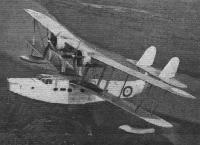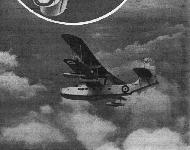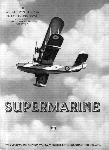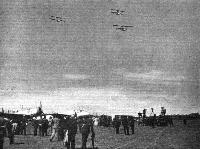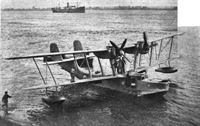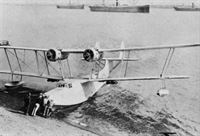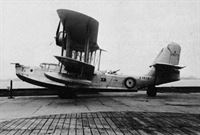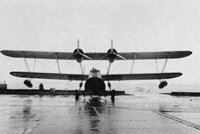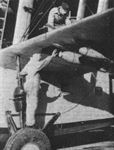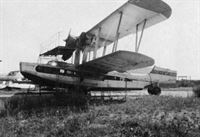
Описание
Страна : Великобритания
Год : 1934
Летающая лодка
Twin-engined long-distance reconnaissance and bombing flying-boat
Варианты
- Supermarine - Swan - 1924 - Великобритания
- Supermarine - Southampton / Solent - 1925 - Великобритания
- Supermarine - Scapa - 1932 - Великобритания
- Supermarine - Stranraer - 1934 - Великобритания
Stranraer
Летающая лодка, двухмоторный цельнометаллический биплан с двухкилевым оперением. Двигатели размещены на верхнем крыле. Создана в КБ фирмы "Супермарин авиэйшн уоркс" под руководством Р. Митчелла. Являлась дальнейшим развитием серии лодок "Саутгемптон" и "Скапа" с дальнейшим увеличением размеров. Предусматривалась перевозка громоздких грузов (авиамоторы, торпеды) на верхней части фюзеляжа. Первоначально именовалась "Саутгемптон" V. Опытный образец лодки "Стрэнрир" ("тип 230") совершил первый полет 27 июля 1934 г. Серийные самолеты начали выпускать с 1936 г. Строительство осуществлялось на заводах "Супермарин" в Саутгемптоне и "Кэнедиэн Виккерс" в Монреале (Канада). Всего выпущено 63 экз. (из них 23 - в Англии и 40 - в Канаде).
Поздние машины и английской, и канадской постройки отличались металлическими трехлопастными винтами вместо деревянных четырехлопастных.
Экипаж - 6-7 чел. Двигатели "Пегасус" X, на канадских машинах последних серий - "Пегасус" XXII. Вооружение 3x7,69, бомбы до 450 кг.
"Стрэнрир" состоял на вооружении в Великобритании с апреля 1937 г., в Канаде - с ноября 1938 г.
Английские самолеты базировались только в метрополии. В сентябре 1939 г. они приступили к регулярному патрулированию Северного моря, забираясь до побережья Норвегии. Использовались как дальние разведчики и охотники за подводными лодками.
Летающие лодки канадских ВВС занимались патрулированием атлантического и тихоокеанского побережий страны. С октября 1941 г. использовались только на Тихом океане. Служили также как транспортные и учебные машины.
В Саутгемптоне производство прекратили в марте 1939 г., в Монреале - в 1941 г. "Стрэнрир" сняли с вооружения строевых частей в Великобритании в апреле 1941 г., как учебные они служили до октября 1942 г. В Канаде использовались как патрульные до февраля 1945 г. Последний самолет канадские ВВС списали в январе 1946г. В гражданской авиации там "стрэнриры" летали до 1963 г.
"Стрэнрир"||
Размах:||25,9 м
Длина:||16,67 м
Моторы, количество х мощность:||2 х 920 л.с.
Взлетная масса, максимальная:||9600 кг
Максимальная скорость:||265 км/ч
Практический потолок:||5600 м
Дальность:||1610 км
Описание:
- Stranraer
- Supermarine Scapa и Stranraer
- Flight, August 1935
THE "STRANRAER''
Фотографии
-
Flight 1937-07 / Flight Advertisements
Регистрационный номер: K7287 [5] -
Air-Britain Aeromilitaria 1984-03
Регистрационный номер: K7287 [5] The first production Stranraer K7287 off Egypt Point, Isle of Wight
-
Flight 1938-05 / Flight
SUPERMARINE STRANRAER: Flying boat (two Pegasus X engines - 850 h.p. at 4,000ft.); span, 85ft; gross weight, 19,000 lb.; max. speed, 165 m.p.h. at 6,000ft.
-
Flight 1935-12 / Flight
A considerable number of Supermarine Stranraer flying boats with 820 h.p. Pegasus engines is to be built for the Royal Air Force.
-
Air-Britain Aeromilitaria 1984-03
Регистрационный номер: K7287 [5] The latest Supermarine pre-war flying boat which may be illustrated is the Stranraer (two Bristol Pegasus engines) shown here. It follows the Scapa in having the engines placed just under the top plane.
Stranraer K7287 on early development flight from Felixstowe. Note the extra fuel tanks fitted to production aircraft. -
Jane's All the World Aircraft 1938 / 03 - All the world's aeroplanes
Регистрационный номер: K7287 [5] "Стрэнрир" британских ВВС в полете
With two Pegasus X engines the Supermarine Stranraer biplane flying boat has a performance comparable with that of some foreign monoplane boats in the same class. -
Flight 1935-08 / Flight
The "Stranraer" (two Bristol "Pegasus") making an overland journey
-
Flight 1937-04 / Flight
Регистрационный номер: K7287 [5] -
Flight 1936-02 / Flight Advertisements
Регистрационный номер: K3973 [9] THE FASTEST TWIN-ENGINED BRITISH FLYING BOAT (PEGASUS ENGINES). "CLIMBS ON ONE ENGINE WITH FULL LOAD."
-
Flight 1935-01 / Flight
FOR OPEN-SEA RECONNAISSANCE: The new Vickers-Supermarine flying boat, fitted with two Bristol "Pegasus" engines.
-
Air-Britain Aeromilitaria 1984-03
The prototype Stranraer silhouetted
-
Flight 1937-05 / Flight
The latest Supermarine flying boat, the Stranraer, is shown here. Note the simple bracing.
-
Air-Britain Aeromilitaria 1984-03
In wartime service, an anti-submarine bomb replaced one long-range tank
-
Flight 1936-04 / Flight Advertisements
Vickers Supermarine "Stranraer"
-
Flight 1936-07 / Flight
Регистрационный номер: K3973 [9] SEAFARER: The first machines of a batch of Supermarine Stranraer flying boats will soon be seen at Southampton. This is the latest version of the prototype, with 840 h.p. Pegasus Xs in place of the earlier IIIs, and three-bladed Fairey airscrews.
-
Flight 1939-05 / Flight
The Supermarine Stranraer is a quite exceptionally pleasant flying machine as demonstrated by pilots of a Felixstowe G.R. squadron.
-
Air-Britain Aeromilitaria 1979-02
Three Supermarine Stranraers of No.228 Squadron carry our a practice fly-past over Calshot for the 1939 Empire Air Day. Noteworthy are the Type B roundels on the leading aircraft although it has yet to be camouflaged. On the ramp are three Singapore IIIs and a London. The old castle built by Henry VIII with its later addition of a control tower can be seen below the tail of the leading Stranraer, surely the oldest control tower in the world.
Другие самолёты на фотографии: Saunders-Roe London / A.27 - Великобритания - 1934Short Singapore III / S.19 - Великобритания - 1934
-
Flight 1936-06 / Flight
Three Vickers-Supermarine Flying Boats in Formation: In the lead is the Walrus, on the right is the Stranraer, and on the left the Scapa.
Другие самолёты на фотографии: Supermarine Scapa - Великобритания - 1932Supermarine Walrus/Seagull V - Великобритания - 1933
-
Aeroplane Monthly 1985-06 / ??? - RAF Pageantry
The flying boats: In the vee, left to right, are the Vickers-Supermarine "Scapa" and "Stranraer," Short "Sarafand" and "Singapore III," and Saro "London"; bringing up the rear is the Saro "Cloud" (Short "Knuckleduster" ???)
Like fish out of water - six flying-boats from Felixstowe. They are, from left to right, Scapa, Stranraer, Sarafand, Singapore, London and, in the rear, the Cloud.Другие самолёты на фотографии: Saunders-Roe London / A.27 - Великобритания - 1934Short Knuckleduster / S.18 - Великобритания - 1933Short Sarafand / S.14 - Великобритания - 1932Short Singapore III / S.19 - Великобритания - 1934Supermarine Scapa - Великобритания - 1932
-
Flight 1936-07 / Flight
Visitors from the seas: the Saro London, two Short Singapore IIIs (centre) and the Supermarine Stranraer.
Другие самолёты на фотографии: Saunders-Roe London / A.27 - Великобритания - 1934Short Singapore III / S.19 - Великобритания - 1934
-
Flight 1935-01 / Flight
Регистрационный номер: K3973 [9] HIGH-SPEED SERVICE DEVELOPMENT: In a leading article last week Flight called attention to the threat to British commercial flying boat supremacy. On the Service side progress is steadier, and the new Vickers-Supermarine flying boat (Bristol "Pegasus" engines), shown in this remarkable photograph, is one of several types now undergoing trials.
-
Flight 1935-05 / Flight
MAKING FRIENDS AT FELIXSTOWE: The new Supermarine "Mark V" flying boat (two "Pegasus III"), on test at Felixstowe last week. Her remarkable take-off is due in no small measure to the 775 h.p. available for that purpose from each of her engines.
-
Мировая Авиация 82
Летающая лодка Stranraer из 240-й эскадрильи взлетает на патрулирование в период 1940-1941 годов. Под каждой нижней плоскостью она несет 110-кг глубинную бомбу.
-
Flight 1936-11 / Flight
Supermarine Stranraer flying boats with 850 h.p. Bristol Pegasus X engines are under construction for the R.A.F. Note, in this view, the "bomb tanks" for long-range work.
-
Aeroplane Monthly 1984-11 / L.Coombs - The expanding years 1936-1939 (1)
R. J. Mitchell's last biplane flying-boat, the Stranraer, was still in service on the outbreak of war.
-
Flight 1935-08 / Flight
A bird's-eye view of the "Stranraer" alighting on the water.
-
Air-Britain Aeromilitaria 1984-03
Three Stranraers of No.209 Squadron in a formation take-off to seaward of Harwich May 1939
-
Air-Britain Aeromilitaria 1984-03
Регистрационный номер: K7297 K7297 of No.209 Squadron at Felixstowe, May 1939
-
Моделист-Конструктор Гидросамолеты Второй мировой войны
"Стрэнрир" взлетает
-
Flight 1935-08 / Flight
Регистрационный номер: K3973 [9] "Pegasus X" engines of 820 h.p. will power the Supermarine "Stranraer." This flying boat has an exceptionally fine all-round performance.
-
Air-Britain Aeromilitaria 1984-03
RCAF 912 on pre-delivery checks
-
Flight 1939-02 / Flight
The first of a batch of ten Supermarine Stranraers (two Pegasus X) for the Royal Canadian Air Force on the St. Lawrence River. Ten are being constructed by Canadian Vickers, Ltd.
-
Моделист-Конструктор Гидросамолеты Второй мировой войны
"Стрэнрир" канадских ВВС стоит на якоре в бухте Элфорд (о-ва Королевы Шарлотты)
-
Jane's All the World Aircraft 1938 / 03 - All the world's aeroplanes
A close-up of the Supermarine "Stranraer" Flying-boat (two Bristol "Pegasus" engines).
-
Air-Britain Aeromilitaria 1980-04
We could not resist printing the photo on the back cover. The scene is Calshot and the boat is a target launch. Its crew appears to be prepared for gas bombs and/or sunstroke since close examination will show that his headgear is a pith helmet and not a tin hat.
These launches had an armoured cabin which protected the crew of three and the topee was to protect them from concussion while gas masks were worn as a protection from CO fumes in the battened-down cabin.
Calshot's target boats used a range in Christchurch Bay, an area obviously treated as a plague spot by local motor boat owners. An obvious parallel was flying one's Moth near a naval force expecting a Queen Bee.
It was these launches that AC.2 Shaw (Lawrence of Arabia was his better-known designation) helped to design, according to his biographers and they were obvious candidates for radio control. Two Singapore IIIs and a Stranraer are in the back ground, or should we say backwater?Другие самолёты на фотографии: Short Singapore III / S.19 - Великобритания - 1934
-
Air-Britain Aeromilitaria 1982-02
Four of No.210 Squadron's Singapores are afloat with a Stranraer of No.228 Squadron. In the background is the RAF floating dock with a fifth Singapore inboard. In the foreground are four more Singapores, two without their outer wing panels, and a hangar under construction. The slipway can be seen on the left with the platform at the water's edge. From the number of people visible, we would guess that the photograph was taken during the Empire Air Day display which most RAF stations, and some civil airports, arranged in May each year.
Другие самолёты на фотографии: Short Singapore III / S.19 - Великобритания - 1934
-
Air-Britain Aeromilitaria 1984-03
Prototype RCAF 907 at Canadian Vickers
-
Flight 1935-05 / Flight
The great crane fishes the new "Pegasus"-powered Supermarine "Mark V" out of the water.
-
Air-Britain Aeromilitaria 1984-03
Регистрационный номер: K3973 [9] -
Air-Britain Aeromilitaria 1984-03
Регистрационный номер: K3973 [9] -
Air-Britain Aeromilitaria 1984-03
RCAF 916 of No.4 (BR) Squadron
-
Flight 1940-04 / Flight
A Canadian-built Supermarine Stranraer. The combination of snow-covered ground and open water should be noted.
-
Flight 1935-05 / Flight
Lowering the big new Supermarine on to its land chassis with Felixstowe's 50-ton crane.
-
Flight 1940-02 / Flight
CANADIAN-SCOTTISH: A Canadian-built Supermarine Stranraer flying boat being bombed-up at Halifax, Nova Scotia.
-
Flight 1935-08 / Flight
Stern Defence: The rear gunner's cockpit in the "Stranraer." Note also the control "tabs" on rudders and elevator.
-
Aeroplane Monthly 1974-03 / Supermarine Stranraer /Preservation Profile/ (11)
On display in the RAF Museum, 1972
-
Aeroplane Monthly 1974-03 / Supermarine Stranraer /Preservation Profile/ (11)
As Alaska Queen with Queen Charlotte Airlines, 1948.
-
Aeroplane Monthly 1974-03 / Supermarine Stranraer /Preservation Profile/ (11)
Afloat at Vancouver, July 1965.
-
Aeroplane Monthly 1974-03 / Supermarine Stranraer /Preservation Profile/ (11)
At Vancouver during overhaul, May 1964.
-
Flight 1939-05 / Flight
A unique ”shot” taken during a turn from the bow cockpit of a Supermarine Stranraer flying boat operating off the East Coast.
-
Air-Britain Aeromilitaria 1984-03
Independence from shore bases was inbuilt in the Stranraer. It carried its own crane which could be fitted to hardpoints on the hull to enable the removal of an engine and its replacement
-
Air-Britain Aeromilitaria 1984-03
To convey a replacement engine, a specially-designed transit mount could be fitted amidships. 'Fifth Pods' are common on 747s but the Stranraer was well ahead.
-
Air-Britain Aeromilitaria 1984-03
The Stranraer specification required the ability to carry a torpedo; fortunately it did not have to be launched.
-
Air-Britain Aeromilitaria 1984-03
Регистрационный номер: K3973 [9] Like the Royal Navy, awnings were provided for shade when the Stranraer was moored in hot climates
-
Flight 1939-02 / Flight
STRANRAERS AND SPITFIRES are flown with equal dexterity by Flt, Lt. A. G, Pickering, A.F.C., the Supermarine test pilot who, together with his colleague F/O. J. K. Quill, A.F.C., demonstrated the powers of the Spitfire at Eastleigh during the recent visit of Sir Kingsley Wood. Flt. Lt. Pickering is seen here “at the wheel” of a Stranraer.
-
Flight 1939-06 / Flight
INDOOR PHOTOGRAPHY: Some interesting close-ups secured recently by a Flight photographer: Stranraer pilot (photo was taken in the air)
, Hampden wireless °P«rator and Sunderland wireless operator. The second and third were taken in the air. -
Flight 1935-08 / Flight
The interior accommodation ot the "Stranraer." On the left, is a view looking towards the pilots' cockpit and forward gun station. The navigator and engineer are accommodated in the compartment ait of the pilots' cockpit. On the right, a view looking towards the tail.
-
Air Enthusiast 1971-06 / ??? - The RAF museum takes shape /Veteran & Vintage/
The hull of the Supermarine Stranraer recently returned from Canada and now at RAF Henlow to be restored before going to Hendon.
-
Flight 1935-02 / Flight Advertisements
Регистрационный номер: K3973 [9] THE FASTEST TWIN ENGINED BRITISH MILITARY FLYING BOAT [PEGASUS ENGINES]
-
Aeroplane Monthly 1989-07
First flight of Supermarine Stranraer: July 27, 1934
-
Моделист-Конструктор Гидросамолеты Второй мировой войны
Supermarine Stranraer
- Фотографии




